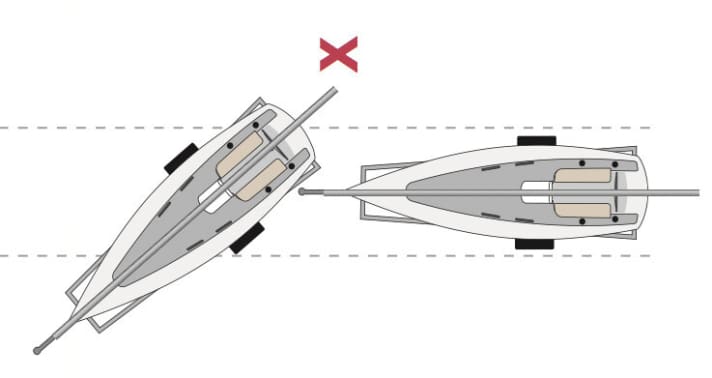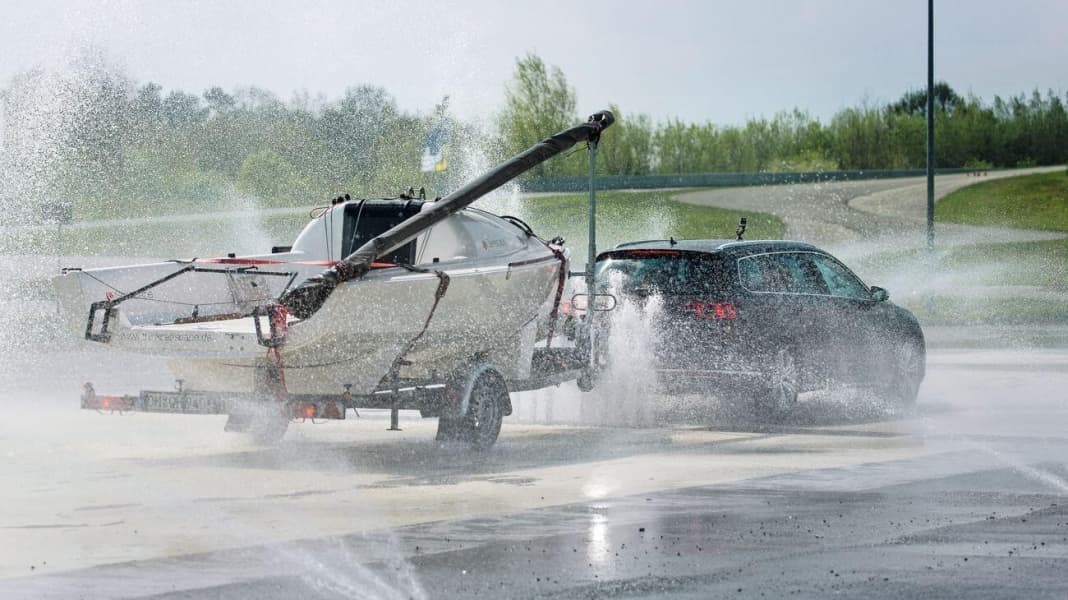
"That wasn't a proper braking manoeuvre again!" For the third time in a row, the ADAC driving safety trainer shakes his head. What does he want? What does he want after all? Any more pressure and the pedal will bend! At least that's how it seems. But the coach is relentless:
You have to really hammer it in!
But you first have to dare to do that - after all, it's not just a trailer on the back, but also a boat. What if something comes loose and the trailer breaks free? Even at 30 kilometres per hour, the trailer decelerates impressively, the seat belts in the car are pulled tight and the body jerks forwards significantly. As the trainer explains, this deceleration can be greater even at such low speeds than when travelling faster.
The moment the brake pedal vibrates and the rubber jolts over the tarmac, it becomes clear that the boat and its load could easily become projectiles with these enormous deceleration forces. This has built up a great deal of respect when it comes to the tests at 40, 50 and 60 kilometres per hour. The most impressive thing is how much the braking distance increases, mainly due to the unbraked trailer. However, there is no sign of swerving or skidding: "Modern driving assistants such as ESP also recognise when a trailer is attached," says the coach, "and react accordingly."
The myth of accelerating while lurching
There is a risk of rolling, especially with very high trailer loads and crosswinds, such as with caravans or when driving downhill. The cause is almost always excessive speed. The only way to counter this is to brake and reduce speed. Under no circumstances should you accelerate on the motorway when lurching, according to a persistent but life-threatening tip.
On the bend track, the trainer then demonstrates that even a trailer weighing less than 750 kilograms can push a four-wheel-drive Passat around with its rear end when braking. Such experiments are, of course, only for trained professionals; the line to tipping the trailer over is too narrow for normal drivers. But even without the stunt interludes, the driving safety training is impressive enough in terms of the increased forces at work.
This type of training is highly recommended for every trailer driver - and always with your own trailer.
This article is part of a trailer special:
- Load securing: correct lashing
- Get to know the driving characteristics of the trailer
- Slip correctly over the ramp
- The best reader tips for slipping
- The big ABC of trailers
- Law and justice
- Maintenance of the trailer
- Trailer insurance
How the braking distance increases with more speed
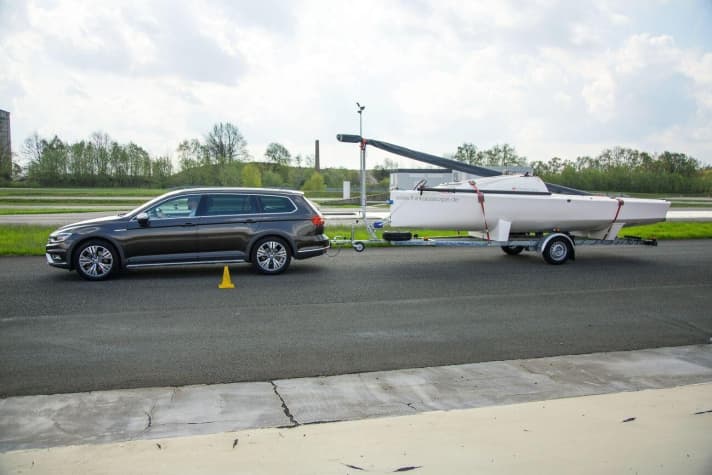
Emergency braking with an unbraked trailer: The moment the front wheels of the car reach the yellow cylinder, the driver depresses the brake pedal. Important: Do not build up the braking force slowly, but with a strong push, then maintain the pressure on the pedal until the vehicle comes to a standstill.
This also requires an appropriate sitting position; the right leg must not be fully extended at full pressure. As the pictures show, the braking distance quadruples at twice the speed.

It also increases compared to driving without a trailer due to the additional trailer load, especially if the trailer is unbraked. For example, an unbraked trailer weighing 750 kilograms can push the towing vehicle considerably more than a much heavier, braked trailer. Even if it is not prescribed, a light trailer with brakes is safer.
Centrifugal force in curves
If the centrifugal force is underestimated when cornering, a trailer can develop a dangerous life of its own. As with the braking distance, the same applies to centrifugal force: double the speed, quadruple the force. Low-lying cars in particular may be able to forgive a corner that is approached a little too briskly, but the situation is different with boat trailers; the higher the centre of gravity of the boat on the trailer, the more dangerous it can become.
Just a little too much speed on a bend or motorway exit and the trailer can tip over. The driver is virtually powerless against this. Once the trailer lifts a wheel, it is usually too late. Possible countermeasures include counter-steering, although this is usually impossible on bends without leaving the carriageway on a left-hand bend or running into oncoming traffic on a right-hand bend.
In any case, it helps to reduce the speed and thus the centrifugal force. This may still be possible with a braked trailer, but an unbraked trailer pushes with its full mass against the angled trailer coupling, which can cause the rear end to break away. The towing vehicle is then pushed into the bend, i.e. into oncoming traffic or off the carriageway. For this reason, always approach bends at no more than the specified maximum speed; it is better to reduce the speed a little beforehand.
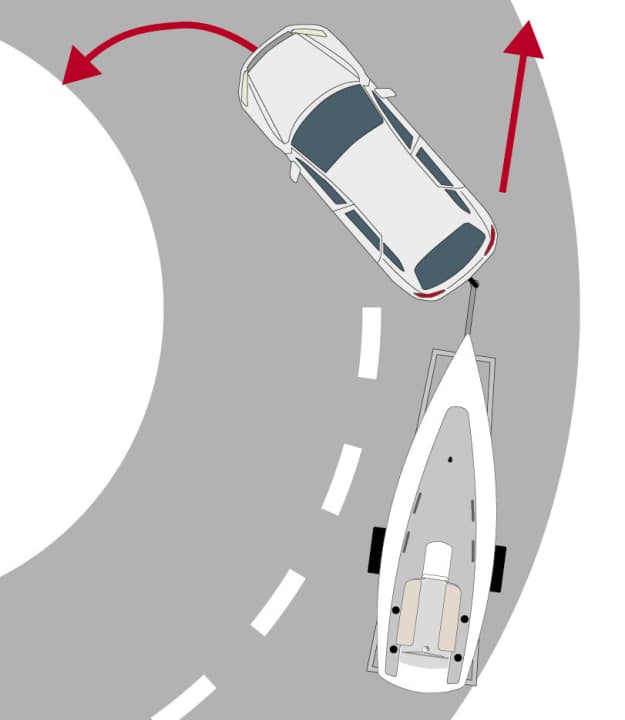
Manoeuvring in the tightest of spaces
An ounce of prevention is worth a pound of cure. This may sound trite, but it is the very first piece of advice that trailer drivers should internalise. Because the longer the trailer, the more difficult it becomes to manoeuvre in confined spaces. A little knowledge, a lot of practice and modern control electronics can defuse many tricky situations. But not all of them. This means manoeuvring the car and trailer as slowly and with as much caution as possible - all the more so the tighter it gets.
However, this not only applies on ramps, when reversing or during turning manoeuvres, but also when driving straight ahead, which is supposedly unproblematic. This is because trailers with boats are usually significantly longer than a trailer from the DIY store or a horse trailer. This means that the axle of the trailer, and therefore its centre of rotation, is far behind the vehicle. The longer this distance, the less precisely the trailer follows the towing vehicle when cornering.
People often forget to swivel out the rear of the trailer. If it is very tight on the left or right, such as in alleyways or when pulling out of a parking space, damage to other vehicles or obstacles can easily occur. Our diagrams show how the towing vehicle usually turns the corner well, but the trailer cuts the corner or swings out.
In all cases, drivers who become unsure in such situations should remain calm and choose a suitable time to manoeuvre, for example when all the lanes in question are empty. Above all, however, they should ask for instructions - from a second person who gives clear hand signals that have been agreed in advance.
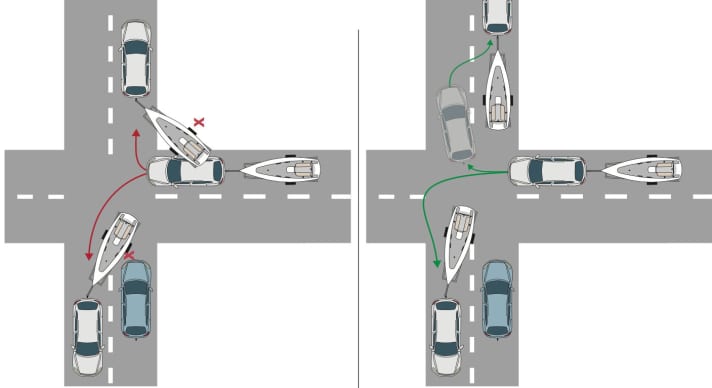
Left half of the picture: taken too close
The trailer does not follow the vehicle exactly in bends, it describes a tighter radius. Turning left is easier, as the driver can see the trailer over his shoulder, whereas turning right is usually only possible via the wing mirror. If the bend is taken too tightly, the trailer can run into oncoming traffic when turning left, taking the kerb with it on the right.
Right half of picture: swivelled out wide
Therefore, the tighter the bend, the further out you should go when cornering. The towing vehicle describes a larger radius than is actually necessary so that the trailer drives round the bend on the ideal radius. This can also mean having to swerve across the oncoming lane. Special attention is then required.
Note overhang
The longer the overhang to the rear, especially in the case of a mast, the more likely it is to swivel outwards on bends and endanger pedestrians or cyclists, or to run into oncoming traffic when turning right.
